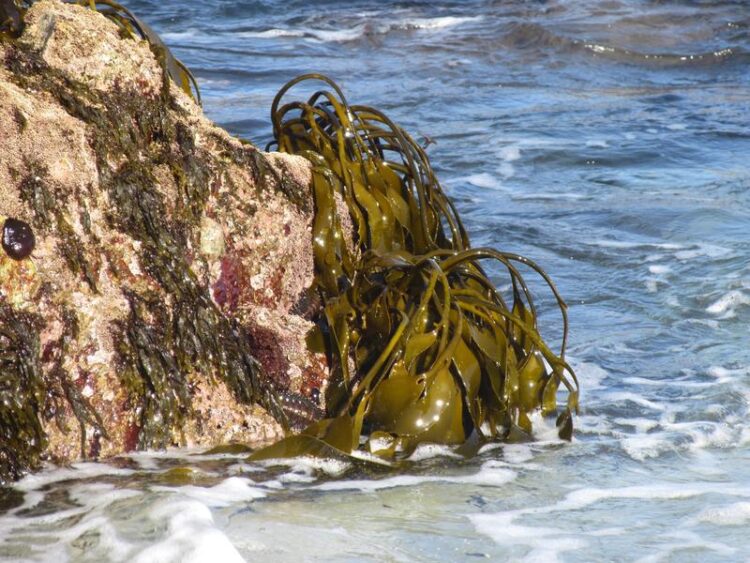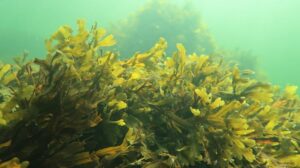Slime for the climate, delivered by brown algae

Brown algae are particularly widespread on rocky shores in temperate and cold latitudes and there absorb large amounts of carbon dioxide from the air worldwide.
Credit: Hagen Buck-Wiese
Brown algae take up large amounts of carbon dioxide from the air and release parts of the carbon contained therein back into the environment in mucous form. This mucus is hard to break down for other ocean inhabitants, thus the carbon is removed from the atmosphere for a long time, as researchers at the Max Planck Institute for Marine Microbiology in Bremen now show. They reveal that the algal mucus called fucoidan is particularly responsible for this carbon removal and estimate that brown algae could thus remove up to 550 million tons of carbon dioxide from the air every year – almost the amount of Germany’s entire annual greenhouse gas emissions.
Brown algae are true wonder plants when it comes to absorbing carbon dioxide from the air. They even outcompete forests on land in this, and thus play a decisive role for the atmosphere and our climate. But what happens to the carbon dioxide after the algae have absorbed it? Researchers at the Max Planck Institute for Marine Microbiology now report in the Proceedings of the National Academy of Sciences (PNAS) that the brown algae can remove large amounts of carbon dioxide from the global cycle in the long term and thus can counteract global warming.
Fucoidan: Brown algae slime is not a favourite dish
Algae take up carbon dioxide from the atmosphere and use the carbon to grow. They release up to a third of the carbon they absorb back into the seawater, for example in the form of sugary excretions. Depending on the structure of these excretions, they are either quickly used by other organisms or sink towards the seafloor.

Credit: Camilla Gustafsson / Tvärminne Zoological Station, Finland
“The excretions of brown algae are very complex and therefore incredibly complicated to measure,” says first author Hagen Buck-Wiese from the Max Planck Institute for Marine Microbiology in Bremen. “However, we have managed to develop a method to analyse them in detail.” With this method, the researchers scrutinised a large number of different substances. The so-called fucoidan turned out to be particularly exciting. “Fucoidan made up about half of the excretions of the brown algae species we studied, the so-called bladderwrack,” says Buck-Wiese. Fucoidan is a recalcitrant molecule. “The fucoidan is so complex that it is very hard for other organisms to use it. No one seems to like it.” As a result, the carbon from the fucoidan does not return to the atmosphere quickly. “This makes the brown algae particularly good helpers in removing carbon dioxide from the atmosphere in the long term – for hundreds to thousands of years.”
Brown algae could bind almost all of Germany’s carbon dioxide emissions
Brown algae are remarkably productive. It is estimated that they absorb about 1 gigaton (one billion tons) of carbon per year from the air. Using the results of the present study, this would mean that up to 0.15 gigatons of carbon, equivalent to 0.55 gigatons of carbon dioxide, are sequestered by brown algae each year in the long term. For comparison: Germany’s annual greenhouse gas emissions currently amount to about 0.74 gigatons of carbon dioxide, according to the Federal Environment Agency (Umweltbundesamt, estimation for 2020).
“And even better: The fucoidan does not contain any nutrients such as nitrogen,” Buck-Wiese explains further. Thus, the growth of the brown algae is not affected by the carbon losses.
More species and sites
For the current study, Buck-Wiese and his colleagues from the MARUM MPG Bridge Group Marine Glycobiology, which is based at both the Bremen Max Planck Institute and MARUM – Centre for Marine and Environmental Sciences at the University of Bremen, conducted their experiments at the Tvärminne Zoological Station in southern Finland. “Next we want to look into other brown algae species and other locations,” says Buck-Wiese. “The great potential of brown algae for climate protection definitely needs to be further researched and utilised.”
Wissenschaftliche Ansprechpartner:
Hagen Buck-Wiese
MARUM MPG Bridge Group Marine Glycobiology
Max Planck Institute for Marine Microbiology, Bremen
Phone: +49 421 2028-7360
E-mail: hbuck@mpi-bremen.de
Dr. Jan-Hendrik Hehemann
MARUM MPG Bridge Group Marine Glycobiology
Max Planck Institute for Marine Microbiology, Bremen
Phone: +49 421 218-65775
E-mail: jheheman@mpi-bremen.de
Dr. Fanni Aspetsberger
Press Officer
Max Planck Institute for Marine Microbiology, Bremen
Phone: +49 421 2028-9470
E-mail: presse@mpi-bremen.de
Originalpublikation:
Hagen Buck-Wiese, Mona A. Andskog, Nguyen P. Nguyen, Margot Bligh, Eero Asmala, Silvia Vidal-Melgosa, Manuel Liebeke, Camilla Gustafsson, Jan-Hendrik Hehemann (2022): Fucoid brown algae inject fucoidan carbon into the ocean. PNAS (December 2022)
Weitere Informationen:
Media Contact
All latest news from the category: Ecology, The Environment and Conservation
This complex theme deals primarily with interactions between organisms and the environmental factors that impact them, but to a greater extent between individual inanimate environmental factors.
innovations-report offers informative reports and articles on topics such as climate protection, landscape conservation, ecological systems, wildlife and nature parks and ecosystem efficiency and balance.
Newest articles

Microscopic basis of a new form of quantum magnetism
Not all magnets are the same. When we think of magnetism, we often think of magnets that stick to a refrigerator’s door. For these types of magnets, the electronic interactions…

An epigenome editing toolkit to dissect the mechanisms of gene regulation
A study from the Hackett group at EMBL Rome led to the development of a powerful epigenetic editing technology, which unlocks the ability to precisely program chromatin modifications. Understanding how…

NASA selects UF mission to better track the Earth’s water and ice
NASA has selected a team of University of Florida aerospace engineers to pursue a groundbreaking $12 million mission aimed at improving the way we track changes in Earth’s structures, such…





















